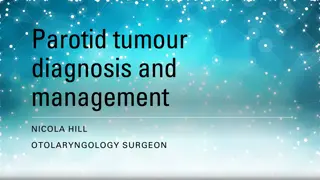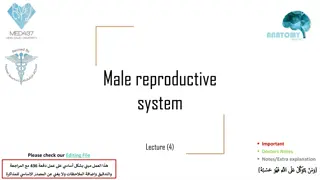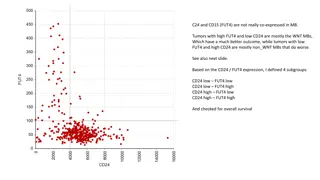MalignantTumors of Intestine
This lecture discusses the epidemiology, pathology, and prognosis of malignant tumors of the intestine, with a focus on colon cancer. It covers the different stages of colorectal adenocarcinoma, the relationship between CEA and recurrence, and the significance of carcinoid tumors.
4 views • 40 slides
Acute Scrotal Swelling
Gain understanding of presentation and management of acute scrotal swelling in pediatric patients. Learn about testicular torsion, differentials, examination findings, and diagnostic investigations.
4 views • 17 slides
Testicular carcinoma
The diagnosis and treatment options for testicular carcinoma from Dr. Shanzah Shahbaz, a medical oncologist. This comprehensive guide covers staging, tumor markers, false elevation risks, chemotherapy regimens, and management of residual masses.
2 views • 15 slides
Zongertinib Trial in HER2 Aberrant Tumors
Zongertinib (BI.1810631) Phase I Study in Advanced Solid Tumors with HER2 Aberrations focusing on NSCLC. The trial involves dose escalation and expansion, testing different doses in cohorts with varied HER2 mutations. Primary endpoints include MTD, OR, and DLTs.
2 views • 14 slides
Understanding Tumor Classification and Nomenclature in Pathology
This slideshow provides an overview of tumor classification, nomenclature, and key concepts in pathology. It covers the definitions of neoplasm, tumor, and oncology, the classification of tumors into benign and malignant categories, as well as the importance of stroma in tumor behavior. It also expl
4 views • 61 slides
HER2 Tyrosine Kinase Inhibitor Zongertinib Phase Ia/b Trial in Solid Tumors
Study on Zongertinib, a HER2 tyrosine kinase inhibitor, in patients with HER2 aberration-positive solid tumors. The trial involves multiple centers worldwide and aims to evaluate the efficacy of Zongertinib in treating various cancers harboring HER2 mutations. Financial disclosures of lead investiga
1 views • 13 slides
neurosurgeon in jaipur-Dr Himanshu Gupta
brain tumor is an abnormal growth of cells in the brain. Tumors can be either cancerous (malignant) or non-cancerous (benign). Cancerous tumors grow and spread aggressively, potentially invading nearby tissues and spreading to other parts of the body, while non-cancerous tumors are usually less aggr
0 views • 5 slides
Understanding Testicular Tumors: Types, Classification, and Clinical Findings
Testicular tumors are predominantly malignant, with germ cell tumors being the most common type. This article delves into the classification of testicular tumors, including primary and secondary, benign and malignant, germ cell, and non-germ cell tumors. Clinical findings such as painless enlargemen
3 views • 31 slides
Evaluation of Acute Scrotum in Children: Clinical Insights and Imaging Findings
Understanding the differential diagnosis of acute scrotum in children is vital, with key considerations for testicular torsion, appendix torsion, epididymitis, orchitis, hematocele, and hernia. Relevant imaging plays a crucial role in ruling out torsion and determining the appropriate management bas
0 views • 12 slides
Understanding Grading and Staging of Malignant Tumors in Cancer Patients
Grading and staging are crucial in determining the aggressiveness and extent of malignant tumors. Grading involves assessing the level of malignancy based on cell differentiation and mitotic activity, while staging considers the size of the tumor, lymph node involvement, and presence of metastases.
7 views • 31 slides
Understanding Testicular Hypoplasia and Degeneration in Veterinary Medicine
Testicular hypoplasia and degeneration are conditions affecting the development and function of the testes in animals, particularly bulls. Hereditary and non-hereditary forms exist, leading to partial or complete failure in spermatogenic epithelium development. The incidence is low and sporadic, mor
0 views • 30 slides
Understanding Impotentia Generandi in Male Animals
Inability or reduced ability to fertilize the ovum due to testis, epididymis, or accessory sex gland pathology is known as Impotentia Generandi. This condition can be associated with normal or abnormal semen production, affecting fertility in male animals. Factors like congenital or acquired defects
0 views • 30 slides
Understanding Impotentia Generandi in Male Animals
Inability or reduced ability to fertilize the ovum due to testicular pathology is known as Impotentia Generandi. It can be associated with abnormal or apparently normal semen production, affecting the fertility of male animals. Conditions such as brucellosis, cryptorchidism, and congenital defects l
0 views • 30 slides
Comprehensive Overview of Parotid Tumor Diagnosis and Management
This comprehensive guide covers the diagnosis and management of parotid tumors, including anatomy, differential diagnosis, and management strategies. It discusses the approach to evaluating patients with neck lumps, differential diagnoses to consider, and the management techniques for both benign an
0 views • 20 slides
Equipment Used for Castration and Testectomy in Food Animals
This informative content illustrates various equipment used for castration and testectomy in food animals. It includes tools like scalpel, castration knife, emasculator, and emasculatome, each serving different purposes in the procedure. The use of these tools ensures efficient and bloodless castrat
0 views • 6 slides
Understanding Gamma Knife Stereotactic Radiosurgery
The Gamma Knife Stereotactic Radiosurgery is a precise and effective treatment method where highly focused radiation beams are used to target tumors and abnormalities in the brain. It does not remove the tumor directly but affects DNA, cell growth, and blood vessels. The procedure involves three mai
0 views • 51 slides
Review of Pathway and Quality of Care for Children and Young People with Testicular Torsion
This review focuses on evaluating the complete care pathway and quality provided to children and young people aged 2-24 years who present to the hospital with testicular torsion. The study emphasizes the importance of raising public awareness, enhancing training for recognizing testicular torsion in
0 views • 20 slides
Understanding Neuroendocrine Tumors: Endocrinology Insights
Delve into the complex world of neuroendocrine tumors (NETs) through a detailed presentation prepared by Dr. Thomas O'Dorisio from the University of Iowa. Explore case reports, therapeutic interventions, and the challenges associated with managing these tumors. Gain valuable insights into the functi
0 views • 24 slides
Veterinary Dental Conditions and Tumors: A Comprehensive Overview
This detailed information covers various dental affections and tumors in veterinary medicine, discussing conditions like dental fistula, odontoma, ameloblastoma, and epulis. It provides insights into the causes, characteristics, and classifications of these oral health issues, offering valuable know
0 views • 9 slides
Understanding Neoplasia: Characteristics and Nomenclature of Tumors
Neoplasia, or new growth, is characterized by uncoordinated growth exceeding that of normal tissues, persistent growth independent of stimuli, loss of responsiveness to growth controls, and local expansion regardless of host environment. Tumors are classified into benign and malignant categories in
0 views • 36 slides
Histiocytic Neoplasia in the Heart: A Rare Case Report
A 3-year-old girl presented with persistent fever, leading to the discovery of a cardiac mass diagnosed as histiocytic neoplasia through imaging and biopsy. Primary cardiac tumors are rare in children, with benign tumors being more common. Histiocytic sarcomas are malignant neoplasms with characteri
0 views • 10 slides
Classification of Tumors: A Comprehensive Overview
Understanding the classification of tumors is crucial in the field of pathology. This detailed overview covers the definitions of neoplasia and tumors, the differentiation between benign and malignant tumors, nomenclature, and characteristics of various tumor types. It discusses the behaviors of ben
1 views • 34 slides
Understanding Pancreatic Cancer: Facts, Tumors, and Risk Factors
Pancreatic cancer, a deadly disease, is on the rise with specific risk factors like age, genetics, and lifestyle choices. Exocrine and endocrine tumors differ in presentation and treatment. Learn about the pancreas's location, statistics, and crucial risk factors associated with this malignancy.
0 views • 19 slides
Understanding PET-CT Imaging in Adrenal Tumors at Tehran University
Tehran University of Medical Sciences' Research Center for Nuclear Medicine specializes in PET-CT imaging for adrenal tumors. Dr. Arman Hassanzadeh-Rad, MD, explains the principles of PET imaging, hybrid imaging combining PET and CT, F-18 FDG use, SUV measurement, and more. PET-CT allows for both at
0 views • 21 slides
Epidemiology and Pathology of Brain Tumors - Overview and Incidence Statistics
This information provides an in-depth overview of the epidemiology, classification, and pathology of brain tumors. It covers the relative incidence of various brain tumors, including astrocytoma, glioblastoma, meningioma, and others. The data also includes statistics on the occurrence of brain tumor
0 views • 98 slides
Understanding Ear Tumors and Cholesteatoma: Causes, Symptoms, and Management
Ear tumors such as Glomus tumor and Acoustic neuroma can affect vital functions of the ear, leading to symptoms like tinnitus, vertigo, hearing loss, and facial nerve disorders. Surgical excision is a common treatment method. Cholesteatoma, an abnormal skin growth in the middle ear, can also cause c
0 views • 13 slides
Male Reproductive System Overview: Anatomy, Function, and Components
This lecture focuses on the male reproductive system, covering the primary and accessory sex organs, external genitalia, and their functions. Students will learn about the testes, epididymis, vas deferens, seminal vesicles, prostate gland, and more. Details on testicular descent, scrotum anatomy, an
0 views • 15 slides
Evaluation of MURR Thermal BNCT Facility for Canine Nasal/Sinus Tumor Treatment
The study evaluates the MURR Thermal BNCT Facility's effectiveness in treating canine nasal/sinus tumors using a phantom. The facility, located at the University of Missouri Research Reactor, offers Boron Neutron Capture Therapy (BNCT) under the direction of Dr. Fred Hawthorne. Key features include
0 views • 21 slides
Understanding Neoplasia and Odontogenic Tumors in Dentistry
Neoplasia refers to abnormal tissue growth surpassing normal growth, persisting excessively even after the initial stimulus. Odontogenic tumors are classified by the WHO in 1992 into benign and malignant categories, with various subtypes described. Ameloblastoma is a true neoplasm of enamel organ ti
0 views • 7 slides
Understanding Cancer Predispositions and Genetics in Pediatric Patients
Exploring cancer predisposition syndromes, basic genetics, and vocabulary related to pediatric cancer risk factors. Topics include CNS tumors, solid tumors, leukemia, hereditary retinoblastoma, and genetic testing guidelines for children with cancer predispositions.
0 views • 36 slides
Overview of Salivary Gland Tumors and Diseases
Salivary gland diseases, including tumors, can affect both major and minor glands. These tumors may be benign or malignant, with common benign tumors like pleomorphic adenoma. Clinical features of salivary gland tumors vary, with slow-growing benign tumors being more common. Pleomorphic adenoma is p
1 views • 27 slides
Understanding Brain Tumors: Classification, Clinical Features & Prognosis
Brain tumors, whether primary or secondary, present with various clinical features such as neurological deficits, seizures, and raised intracranial pressure. The classification includes common types like gliomas, meningiomas, and medulloblastomas. Astrocytomas are the most common primary intracrania
0 views • 22 slides
Expression Patterns of CD24 and FUT4 in Medulloblastoma
CD24 and FUT4 show distinct expression patterns in medulloblastoma, impacting tumor subtypes and patient outcomes. Tumors with high FUT4 and low CD24 are associated with favorable WNT subtype and better survival, while tumors with low FUT4 and high CD24 tend to have a poorer prognosis. Subgroups bas
0 views • 4 slides
Overview of Renal Tumors: Benign and Malignant Forms
Explore the spectrum of renal tumors, from benign papillary adenomas and oncocytomas to malignant renal cell carcinomas like clear cell carcinoma. Images and descriptions showcase the gross pathology and histopathology of these tumors. Learn about the features and prognosis of different renal tumor
0 views • 31 slides
Thymic Neuroendocrine Tumors: Demographics, Treatment, and Survival Study
This study presents an analysis of thymic neuroendocrine tumors (TNET) focusing on demographics, treatment, and survival outcomes. Conducted as a retrospective cohort study using the NCDB data from 2004 to 2015, the study aimed to examine the characteristics of TNET in terms of demographics, clinica
0 views • 16 slides
Survivorship Issues and Treatment Advances in Testicular Cancer
Testicular cancer poses challenges impacting fertility, sexuality, and body image. Treatment involves chemotherapy, surgery, and clinical trials. Survivorship issues include early problems, toxicities, and late effects, highlighting the need for life-stage support. Innovations in tailored chemothera
0 views • 13 slides
Intracranial Gliomas: Radiology, Diagnosis, and Management Overview
This comprehensive overview covers the classification, subtypes, and spatial definitions of intracranial gliomas, including astrocytic tumors, oligodendrogliomas, ependymal tumors, neuronal tumors, pineal tumors, and embryonal tumors. It also discusses low-grade gliomas and spatial definitions based
0 views • 38 slides
Neurosurgical Oncology A Complex Field of Cancer Treatment
Neurosurgical oncology is a specialized field of medicine that focuses on the surgical treatment of brain and spinal cord tumors. These tumors can be benign (non-cancerous) or malignant (cancerous), and their location and type can significantly impac
0 views • 3 slides
Neurosurgical Oncology A Complex Field of Cancer Treatment
Neurosurgical oncology is a specialized field of medicine that focuses on the surgical treatment of brain and spinal cord tumors. These tumors can be benign (non-cancerous) or malignant (cancerous), and their location and type can significantly impac
0 views • 3 slides
Symptomatic Control of Functioning Pancreatic NET
Pancreatic neuroendocrine tumors (panNETs) can be classified as functioning or non-functioning, with functioning tumors producing active hormones such as insulin, glucagon, gastrin, or VIP. Symptomatic control is crucial for managing these tumors, with diagnoses based on clinical syndromes and hormo
0 views • 19 slides







































